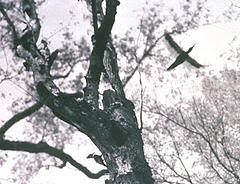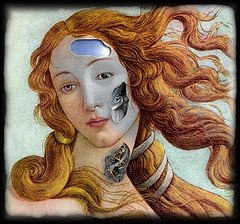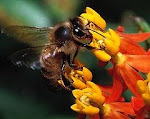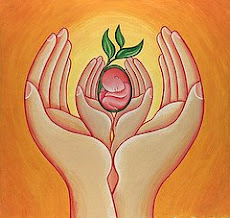Aims
Reading a text out loud: sentence stress, intonation and eye contact; the second conditional - If I were you, I would be...; empathy for animals and plants; understanding the debate surrounding the intrinsic value of all life forms.
Introduction
In the previous section we looked at the notion of the instrumental value of nature as an argument to protect biodiversity. In this section we look at 'intrinsic value': that all of nature has worth irrespective of how useful it is to people (ten Have, 2006).
According to Meffe(2003) the word 'value' is related to the noun form of the word 'good'. Good is the same as 'interest'. Now, the interests/goods/values of an organism are the things it requires to attain its goals. The basic goals of any animal or plant is survival and reproduction. So the interests/goods/values of a gold crest (Europe's smallest bird) are to live in conifer forests, because this is where it finds its food and its nest sites. So, to say the gold crest has intrinsic value is to say that it has its own interests.
Referring to the Nobel prize winning physicist Ernst Shrodinger, Rolston (2006) argues that all organisms practise a kind of conservation biology; that is, they protect and conserve their own life. This is their prime concern, and it has been going on since life emerged over 3.5 billion years ago! He asserts that implicit in the idea of life is the notion of continuation or survival. In other words all living things have one thing in common, they all value being alive over being dead.
Understanding that all living things have this interest in common helps us identify with them; this leads to a mutual respect. I remember Brian Edwards, the former host of the New Zealand Saturday morning radio show 'Top of the Morning' reporting a listener's views on the the brutal culling of the brush tailed possum. Damaging as they were to the New Zealand native forest they were still in the end, not unlike us, "...just trying to survive."
The feeling that we should respect possums not only comes from our ability to empathise with them, but also our imaginations. We are capable of projecting ourselves into the skin of animals, and imagining what it must be like to be them. The following extracts do just that.
Listening
Go to Harper Audio. Find Part 1. Listen to J.R.R.Tolkien reading selections from The Two Towers, the second book in the Lord of the Rings trilogy. Here the two hobbits, Pippen and Merry are being questioned by the ent Treebeard (see Figure 1 at the top of this post). Move the slider bar to minute 3:07 and listen to minute 4:05. While you listen identify which words Tolkien stresses. The text is provided below:
'An Ent? said Merry. 'What's that? But what do you call yourself? What's your real name? 'Hoo now!' replied Treebeard. Hoo! Now that would be telling! Not so hasty. And I am doing the asking. you are in my country. What are you, I wonder? I cannot place you. You do not seem to come in the old lists that I learned when I was young. That was a long, long time ago and they may have made new lists. Let me see! Let me see! How did it go?
Learn now the lore of Living Creatures!
First name the four, the free peoples:
Eldest of all, the elf-children;
Dwarf the delver, dark are his houses;
Ent the earthborn, old as mountains
Man the mortal, master of horses:
Learn now the lore of Living Creatures!
From The Two Towers by J.R.R.Tolkien p.453
Answers
Reading a text out loud - Sentence stress
Stress in English falls on the key words in the sentence. These words are called content words, and carry most of the meaning. If you were only to say these words the listener would be able to grasp the general meaning. The other words are not stressed, they are called structure ( also called function words), and they make the sentence grammatically correct. If you eliminated these words you could still understand the sentence (Beare, 2009). Here is a list of the types of content and structure words adapted from Beare (2009).
Content words:
Nouns, verbs, adjectives and adverbs. Please note, that we do not systematically stress each one of these types of words but principally those which convey the most meaning.
Structure words:
Determiners (a, the, this, that, some, any, a few etc.), auxiliary verbs (do, does, can, have, etc.), prepositions (after, before, in, on, above, etc.), conjunctions (because, as, while, and, etc.) and pronouns (he, her, they, etc.).
Eye contact with the listeners is made to enhance understanding or put emphasis on certain words or phrases that speak about extraordinary or particularly interesting information.
Timing and Rhythm
English is known as a 'stressed timed language'. That means that the time between stressed words is kept more or less the same. This creates a rhythm of:
stressed-unstressed-stressed-unstressed, stressed etc: / - / - /
Consider the following lines from E.E.Cummings' poem, 'somewhere i have never traveled'. The words in bold are verbs, nouns, adjectives and adverbs. When they are removed from the text, notice that the essential meaning is still preserved.
or if your wish be to close me, i and my life will shut very beautifully, suddenly,as when the heart of this flower imagines the snow carefully everywhere descending;
wish be close
life shut beautifully
suddenly
heart flower imagines
snow carefully descending
The poem was featured in Woody Allen's movie Hannah and Her Sisters. You can go to Youtube and watch the clip. At the conclusion of the character Lee reads stanzas 3 and 5: http://www.youtube.com/watch?v=-TSf8hsJTps
You will find that if you place stress in the correct places, and use correct eye contact while reading you will quite simply be better understood and appreciated by native speakers.
Reading Seminar
In small groups of 2 or 3 read one of the extracts and answer the questions together. Then split up and form a group with two other students who have read different extracts. In your groups exchange the information.
Now, each person in the group should have a speaking role. Divide the text you have been given into parts, and assign a part to a student. Identify the sentence stress, practise reading your passage out loud with your partner. Present your extract to the rest of the class in the following way:
Introduction: Explain briefly what your text is about. You could simply paraphrase the introduction to each extract if you like.
Vocabulary: Put on the board the vocabulary list and any other new words you have encounterd and give definitions.
Reading: Each student in the group should read part of the extract to the class using the speaking techniques above. The key words are coloured in blue.
Analysis: Answer the questions relating to your extract for the class
Extract 1
Siddhartha is the story of the son of a Brahmin. He leaves his home to seek enlightenment by himself, though accompanied by his loyal friend Govinda. The scene, you are about to read, finds him with a group of wandering ascetics called the Samanas. They practise extreme poverty and the mortification of the flesh as techniques to attain nirvana.
Instructed by the eldest of the Samanas, Siddhartha practiced the eradication of ego, practiced samadhi according to new Samana rules. A heron flew over the bamboo forest - and Siddhartha received the heron into his soul, flew over forests and mountains, was a heron, ate fish, felt the pangs of heron hunger, spoke in heron squawks, died a heron death. A dead jackal lay on the sandy bank - and Siddhartha's soul slipped into the corpse, was dead jackal, lay on the beach, grew bloated, stank, decayed, was torn apart by hyenas and flayed by vultures, became a skeleton, became dust, blew into the fields. And Siddhartha's soul returned -it had died, had decayed, become dust, it has tasted the bleak euphoria of the cyclical journey, and then, freshly thirsty, it waited, crouching like a hunter for the gap in the cycle where escape was possible, where the end of causality began, an eternity free of sorrow. He killed off his senses, he slipped from his Self to enter a thousand new shapes - was an animal, was cadaver, was stone, was wood, was water - and each time he awakened he found himself once more. The sun would be shining , or else the moon , and he was once more a Self oscillating in the cycle; he felt thirst, overcame the thirst, felt new thirst .
Siddhartha by Herman Hesse p.14 . Translation by Susan Bernofsky
Extract 2
They made noises and at first he was frightened at them. Then moved. He placed his paw on one, and its movements were accelerated. This was a source of enjoyment to him. He smelled it. He picked it up in his mouth. It struggled and tickled his tongue. At the same time he was made aware of the sensation of hunger. There was a crunching of fragile bones, and warm blood ran in his mouth. The taste of it was good. This was meat, the same as his mother gave him, only it was alive between his teeth and therefore better. So he ate the ptarmigan. Nor did he stop till he had devoured the whole brood. Then he licked his chops in quite the same way his mother did, and began to crawl out of the bush.
White Fang by Jack London p.72
The following extracts come from part two of the trilogy The Lord of the Rings, called The Two Towers by J.R.R. Tolkien. Here the two hobbits (hobbits are small human like creatures) have been sent to the forests to encourage the ents (ents are tree like creatures, see Tom Loback's illustration above) to join a fight against the forces of Saruman. Read the following passages which include a description of the ent Treebeard, and the elves attempts to communicate with the trees and ent drink.
They found that they were looking at a most extraordinary face. It belonged to a Man-like, almost Troll-like, figure, at least fourteen foot high, very sturdy, with a tall head, and hardly any neck. Whether it was clad in stuff like green and grey bark, whether that it was its hide, was difficult to say...The lower part of the long face was convered with a sweeping grey beard, bushy, almost twiggy at the roots, thin and mossy at the ends. But at that moment the hobbits noted little but the eyes. These deep eyes were now surveying them, slow and solemn, but very penetrating. They were brown, shot with green light. Often afterwards Pippin tried to describe his first impression. 'One felt as if there was an enormous well behind them, filled up with ages of memory and, long, slow, steady thinking; but their surface was sparkling with the present; like the sun shimmering on the outer leaves of a vast tree, or on ripples of a very deep lake.' (p.452)
Some of my kin look just like trees now, and need something great to rouse them; and they speak only in whispers. But some of my trees are limb-lithe, and many can talk to me. Elves began it, of course, waking trees up and teaching them to speak and learning their tree-talk. They always wished to talk to everything, the old Elves did. (p.457)
The drink was like water, indeed very like the taste of the draughts they had drunk from entwash near the borders of the forest, and yet there was some scent or savour in it which they could not describe: it was faint, but it reminded them of the smell of a distant wood borne from afar by a cool breeze at night. The effect of the draught began at the toes, and rose steadily through every limb, bringing refreshment and vigour as it coursed upwards, right to the tips of the hair. Indeed the hobbits felt that the hair on their heads was actually standing up, waving and curling and growing. (p.460)
From J.R.R.Tolkien - The Two Towers - Book II of The Lord of the Rings
*
*
Vocabulary *
1) Retell in your own words (i.e. paraphrase) the young wolf's first experience of eating live food.
2) Environmental philosopher Holmes Rolston III says all animals have interest (concerns or goods). What interests of both the ptarmigan and wolf are expressed in this extract?
3) Explain the writer's choice of the word 'chops' in the last paragraph.
sturdy, hardly, clad, bark, hides, weeping, bushy, twiggy, mossy, well, shimmering, ripples, to rouse, kin, limb-lithe, draughts, scent, faint, borne
*
Images courtesy of Flickr
TREEBEARD - illustration by Tom Loback by Tom Loback
Links to related Nature Art & Language lessons:
Empathy and the Girl with Pearl Earring








+II+-+socialist+art+by+night+_eulen.jpg)









No comments:
Post a Comment